University Organizational Behavior Report: Leadership and Its Impact
VerifiedAdded on 2020/04/15
|10
|1729
|121
Report
AI Summary
This report analyzes the critical role of leadership in organizational behavior, drawing on Puranik's (2017) work and referencing James MacGregor Burns. The investigation focuses on the impact of leadership styles on organizational success, emphasizing the need for suitable leaders. The report employs qualitative analysis, examining various leadership models and emotional intelligence. Key findings highlight leadership as crucial for business success, with a focus on the importance of contextual and social leadership abilities. It explores the relation between leadership and employee behavior, and offers critical evaluations of different leadership models, including the five-factor model and resonant leadership. Positive leadership traits such as communication, experience, and trust are discussed, along with negative aspects like favoritism, hypocrisy, and inexperience. The report also touches on the application of leadership in real-life scenarios, such as Hyundai's leadership evolution. The report concludes with a discussion of strategic leadership and its alignment with organizational strategy.
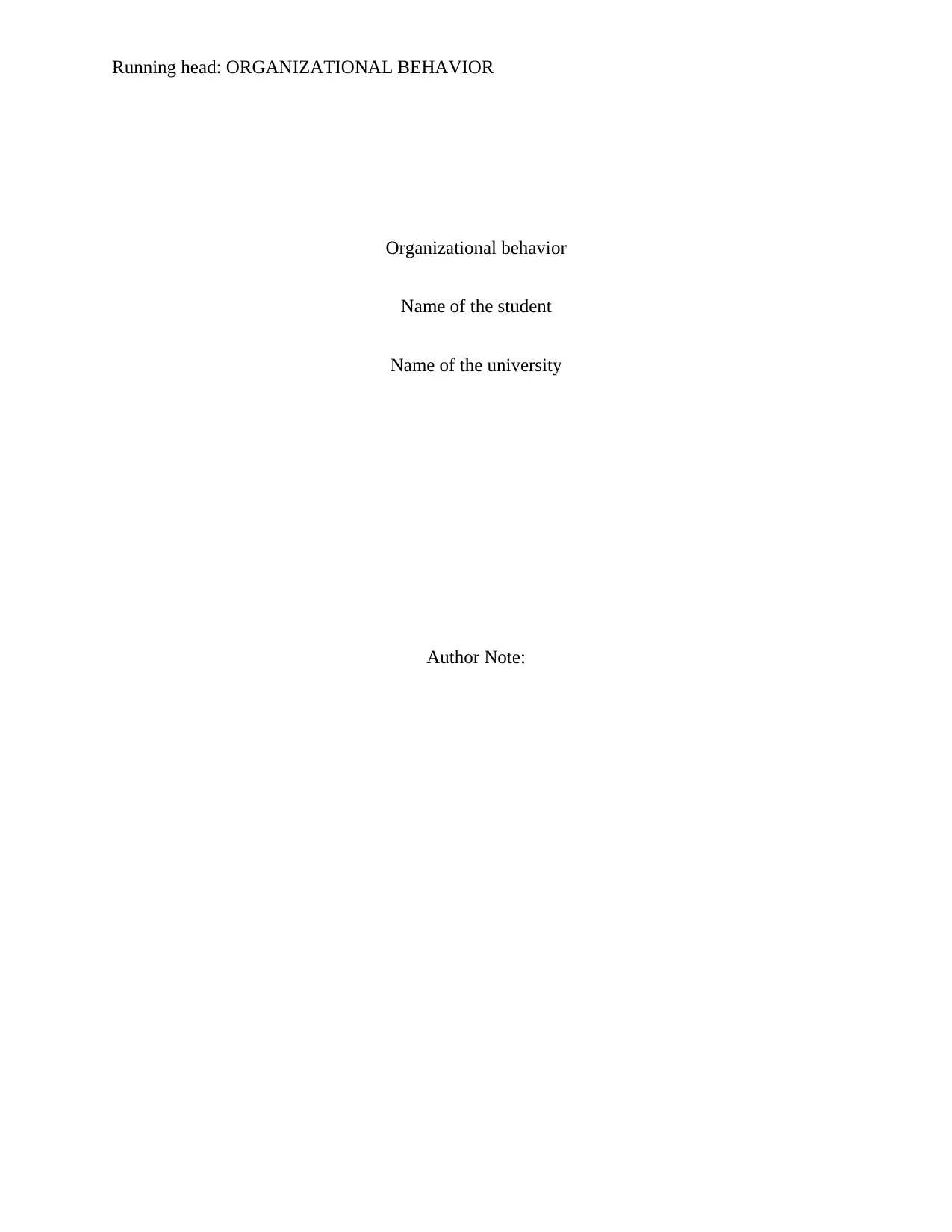
Running head: ORGANIZATIONAL BEHAVIOR
Organizational behavior
Name of the student
Name of the university
Author Note:
Organizational behavior
Name of the student
Name of the university
Author Note:
Paraphrase This Document
Need a fresh take? Get an instant paraphrase of this document with our AI Paraphraser
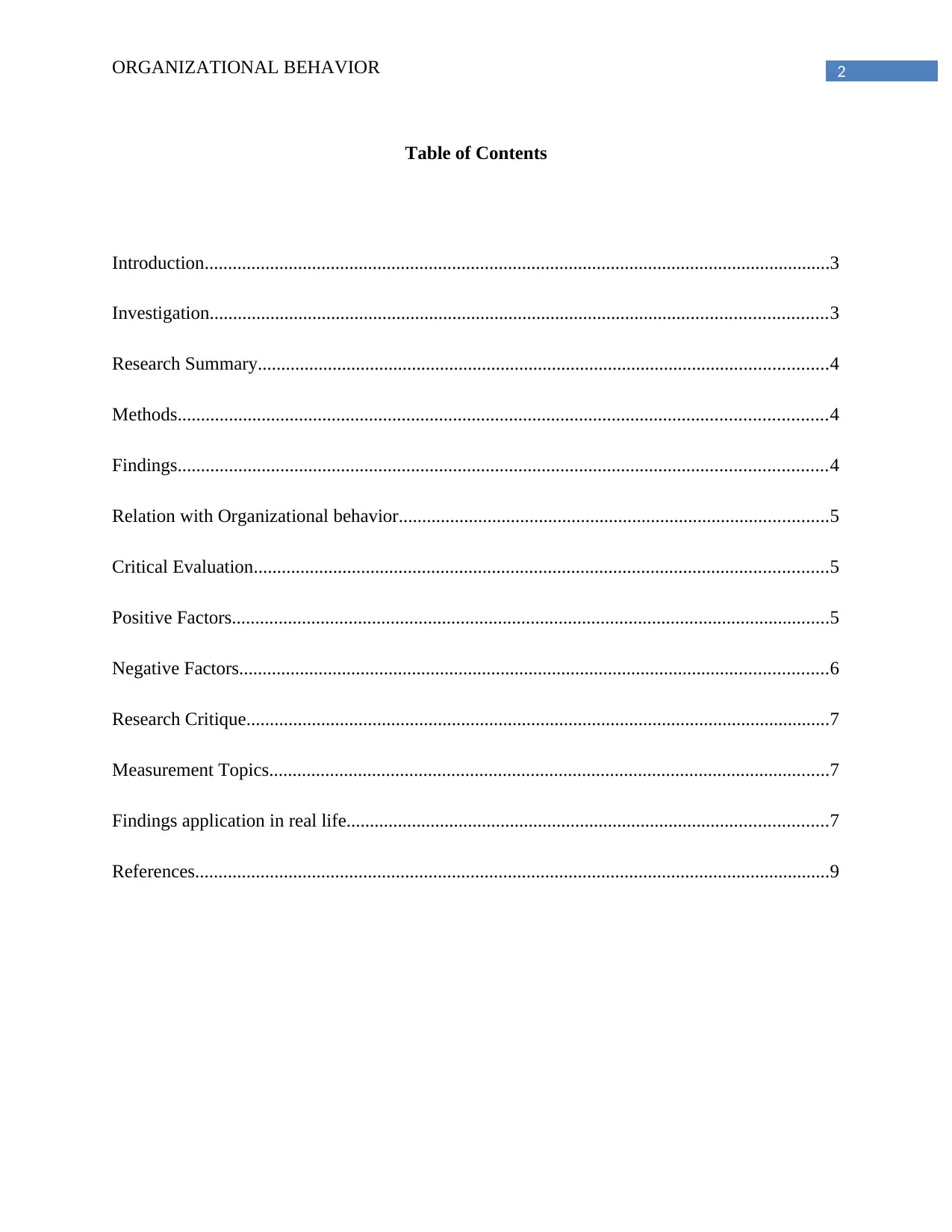
2ORGANIZATIONAL BEHAVIOR
Table of Contents
Introduction......................................................................................................................................3
Investigation....................................................................................................................................3
Research Summary..........................................................................................................................4
Methods...........................................................................................................................................4
Findings...........................................................................................................................................4
Relation with Organizational behavior............................................................................................5
Critical Evaluation...........................................................................................................................5
Positive Factors................................................................................................................................5
Negative Factors..............................................................................................................................6
Research Critique.............................................................................................................................7
Measurement Topics........................................................................................................................7
Findings application in real life.......................................................................................................7
References........................................................................................................................................9
Table of Contents
Introduction......................................................................................................................................3
Investigation....................................................................................................................................3
Research Summary..........................................................................................................................4
Methods...........................................................................................................................................4
Findings...........................................................................................................................................4
Relation with Organizational behavior............................................................................................5
Critical Evaluation...........................................................................................................................5
Positive Factors................................................................................................................................5
Negative Factors..............................................................................................................................6
Research Critique.............................................................................................................................7
Measurement Topics........................................................................................................................7
Findings application in real life.......................................................................................................7
References........................................................................................................................................9
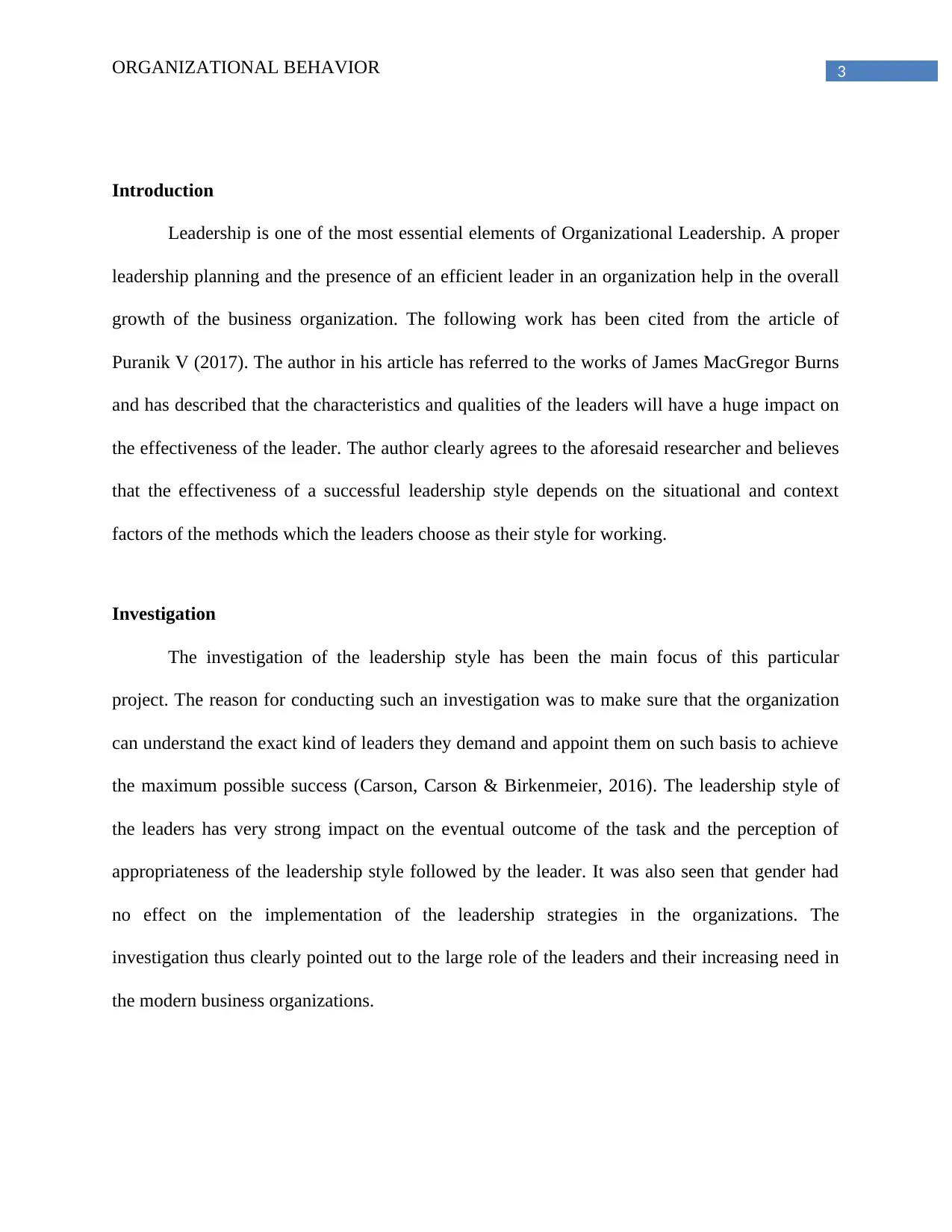
3ORGANIZATIONAL BEHAVIOR
Introduction
Leadership is one of the most essential elements of Organizational Leadership. A proper
leadership planning and the presence of an efficient leader in an organization help in the overall
growth of the business organization. The following work has been cited from the article of
Puranik V (2017). The author in his article has referred to the works of James MacGregor Burns
and has described that the characteristics and qualities of the leaders will have a huge impact on
the effectiveness of the leader. The author clearly agrees to the aforesaid researcher and believes
that the effectiveness of a successful leadership style depends on the situational and context
factors of the methods which the leaders choose as their style for working.
Investigation
The investigation of the leadership style has been the main focus of this particular
project. The reason for conducting such an investigation was to make sure that the organization
can understand the exact kind of leaders they demand and appoint them on such basis to achieve
the maximum possible success (Carson, Carson & Birkenmeier, 2016). The leadership style of
the leaders has very strong impact on the eventual outcome of the task and the perception of
appropriateness of the leadership style followed by the leader. It was also seen that gender had
no effect on the implementation of the leadership strategies in the organizations. The
investigation thus clearly pointed out to the large role of the leaders and their increasing need in
the modern business organizations.
Introduction
Leadership is one of the most essential elements of Organizational Leadership. A proper
leadership planning and the presence of an efficient leader in an organization help in the overall
growth of the business organization. The following work has been cited from the article of
Puranik V (2017). The author in his article has referred to the works of James MacGregor Burns
and has described that the characteristics and qualities of the leaders will have a huge impact on
the effectiveness of the leader. The author clearly agrees to the aforesaid researcher and believes
that the effectiveness of a successful leadership style depends on the situational and context
factors of the methods which the leaders choose as their style for working.
Investigation
The investigation of the leadership style has been the main focus of this particular
project. The reason for conducting such an investigation was to make sure that the organization
can understand the exact kind of leaders they demand and appoint them on such basis to achieve
the maximum possible success (Carson, Carson & Birkenmeier, 2016). The leadership style of
the leaders has very strong impact on the eventual outcome of the task and the perception of
appropriateness of the leadership style followed by the leader. It was also seen that gender had
no effect on the implementation of the leadership strategies in the organizations. The
investigation thus clearly pointed out to the large role of the leaders and their increasing need in
the modern business organizations.
⊘ This is a preview!⊘
Do you want full access?
Subscribe today to unlock all pages.

Trusted by 1+ million students worldwide
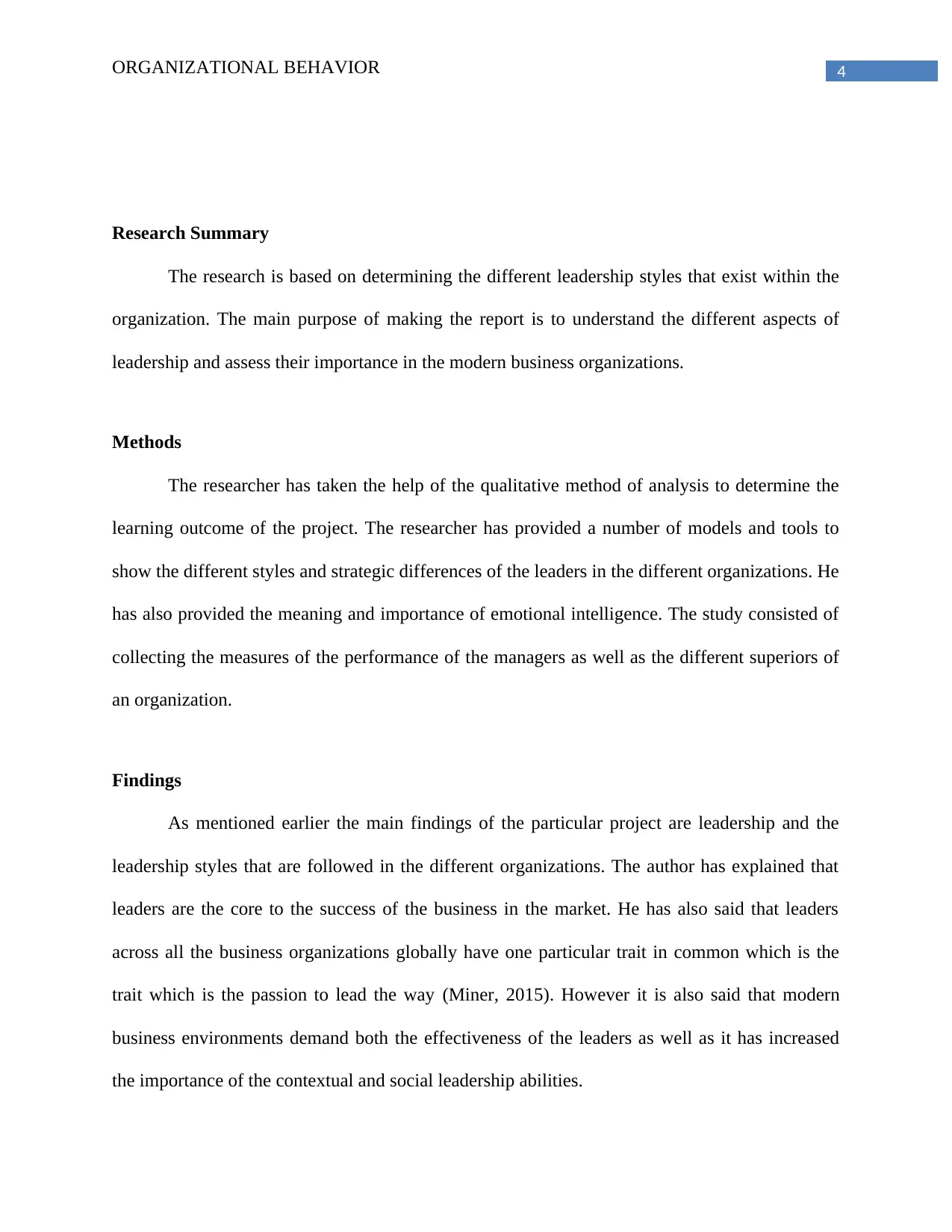
4ORGANIZATIONAL BEHAVIOR
Research Summary
The research is based on determining the different leadership styles that exist within the
organization. The main purpose of making the report is to understand the different aspects of
leadership and assess their importance in the modern business organizations.
Methods
The researcher has taken the help of the qualitative method of analysis to determine the
learning outcome of the project. The researcher has provided a number of models and tools to
show the different styles and strategic differences of the leaders in the different organizations. He
has also provided the meaning and importance of emotional intelligence. The study consisted of
collecting the measures of the performance of the managers as well as the different superiors of
an organization.
Findings
As mentioned earlier the main findings of the particular project are leadership and the
leadership styles that are followed in the different organizations. The author has explained that
leaders are the core to the success of the business in the market. He has also said that leaders
across all the business organizations globally have one particular trait in common which is the
trait which is the passion to lead the way (Miner, 2015). However it is also said that modern
business environments demand both the effectiveness of the leaders as well as it has increased
the importance of the contextual and social leadership abilities.
Research Summary
The research is based on determining the different leadership styles that exist within the
organization. The main purpose of making the report is to understand the different aspects of
leadership and assess their importance in the modern business organizations.
Methods
The researcher has taken the help of the qualitative method of analysis to determine the
learning outcome of the project. The researcher has provided a number of models and tools to
show the different styles and strategic differences of the leaders in the different organizations. He
has also provided the meaning and importance of emotional intelligence. The study consisted of
collecting the measures of the performance of the managers as well as the different superiors of
an organization.
Findings
As mentioned earlier the main findings of the particular project are leadership and the
leadership styles that are followed in the different organizations. The author has explained that
leaders are the core to the success of the business in the market. He has also said that leaders
across all the business organizations globally have one particular trait in common which is the
trait which is the passion to lead the way (Miner, 2015). However it is also said that modern
business environments demand both the effectiveness of the leaders as well as it has increased
the importance of the contextual and social leadership abilities.
Paraphrase This Document
Need a fresh take? Get an instant paraphrase of this document with our AI Paraphraser
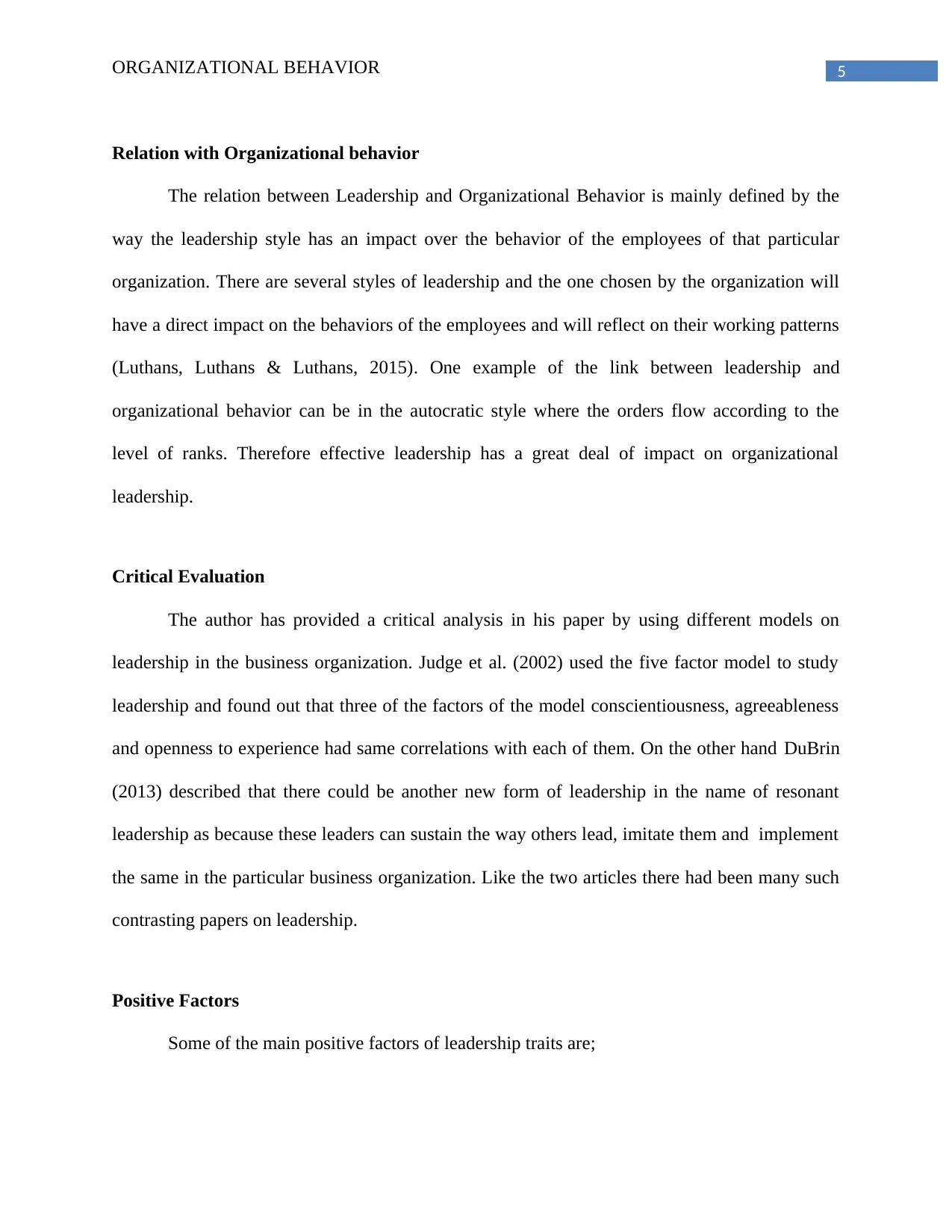
5ORGANIZATIONAL BEHAVIOR
Relation with Organizational behavior
The relation between Leadership and Organizational Behavior is mainly defined by the
way the leadership style has an impact over the behavior of the employees of that particular
organization. There are several styles of leadership and the one chosen by the organization will
have a direct impact on the behaviors of the employees and will reflect on their working patterns
(Luthans, Luthans & Luthans, 2015). One example of the link between leadership and
organizational behavior can be in the autocratic style where the orders flow according to the
level of ranks. Therefore effective leadership has a great deal of impact on organizational
leadership.
Critical Evaluation
The author has provided a critical analysis in his paper by using different models on
leadership in the business organization. Judge et al. (2002) used the five factor model to study
leadership and found out that three of the factors of the model conscientiousness, agreeableness
and openness to experience had same correlations with each of them. On the other hand DuBrin
(2013) described that there could be another new form of leadership in the name of resonant
leadership as because these leaders can sustain the way others lead, imitate them and implement
the same in the particular business organization. Like the two articles there had been many such
contrasting papers on leadership.
Positive Factors
Some of the main positive factors of leadership traits are;
Relation with Organizational behavior
The relation between Leadership and Organizational Behavior is mainly defined by the
way the leadership style has an impact over the behavior of the employees of that particular
organization. There are several styles of leadership and the one chosen by the organization will
have a direct impact on the behaviors of the employees and will reflect on their working patterns
(Luthans, Luthans & Luthans, 2015). One example of the link between leadership and
organizational behavior can be in the autocratic style where the orders flow according to the
level of ranks. Therefore effective leadership has a great deal of impact on organizational
leadership.
Critical Evaluation
The author has provided a critical analysis in his paper by using different models on
leadership in the business organization. Judge et al. (2002) used the five factor model to study
leadership and found out that three of the factors of the model conscientiousness, agreeableness
and openness to experience had same correlations with each of them. On the other hand DuBrin
(2013) described that there could be another new form of leadership in the name of resonant
leadership as because these leaders can sustain the way others lead, imitate them and implement
the same in the particular business organization. Like the two articles there had been many such
contrasting papers on leadership.
Positive Factors
Some of the main positive factors of leadership traits are;
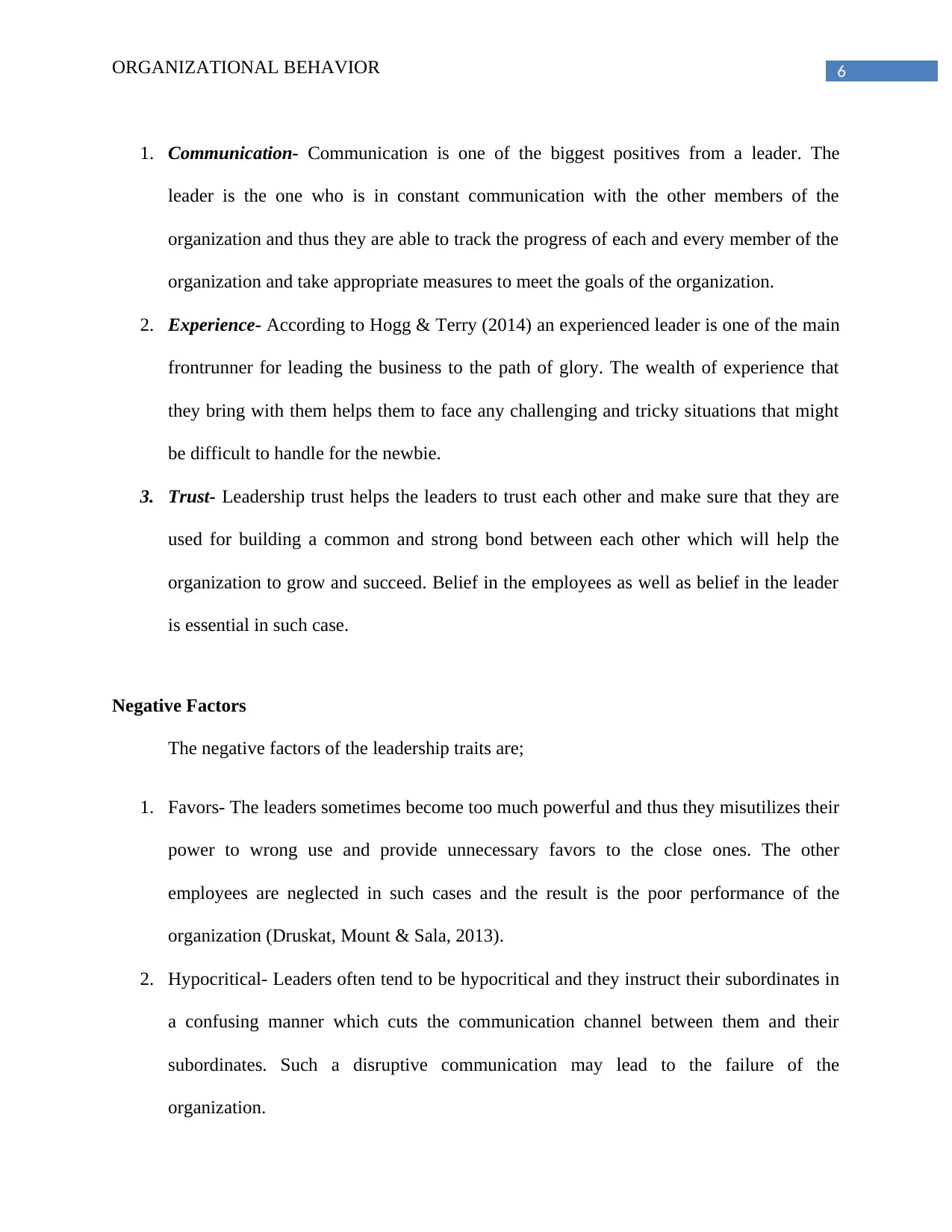
6ORGANIZATIONAL BEHAVIOR
1. Communication- Communication is one of the biggest positives from a leader. The
leader is the one who is in constant communication with the other members of the
organization and thus they are able to track the progress of each and every member of the
organization and take appropriate measures to meet the goals of the organization.
2. Experience- According to Hogg & Terry (2014) an experienced leader is one of the main
frontrunner for leading the business to the path of glory. The wealth of experience that
they bring with them helps them to face any challenging and tricky situations that might
be difficult to handle for the newbie.
3. Trust- Leadership trust helps the leaders to trust each other and make sure that they are
used for building a common and strong bond between each other which will help the
organization to grow and succeed. Belief in the employees as well as belief in the leader
is essential in such case.
Negative Factors
The negative factors of the leadership traits are;
1. Favors- The leaders sometimes become too much powerful and thus they misutilizes their
power to wrong use and provide unnecessary favors to the close ones. The other
employees are neglected in such cases and the result is the poor performance of the
organization (Druskat, Mount & Sala, 2013).
2. Hypocritical- Leaders often tend to be hypocritical and they instruct their subordinates in
a confusing manner which cuts the communication channel between them and their
subordinates. Such a disruptive communication may lead to the failure of the
organization.
1. Communication- Communication is one of the biggest positives from a leader. The
leader is the one who is in constant communication with the other members of the
organization and thus they are able to track the progress of each and every member of the
organization and take appropriate measures to meet the goals of the organization.
2. Experience- According to Hogg & Terry (2014) an experienced leader is one of the main
frontrunner for leading the business to the path of glory. The wealth of experience that
they bring with them helps them to face any challenging and tricky situations that might
be difficult to handle for the newbie.
3. Trust- Leadership trust helps the leaders to trust each other and make sure that they are
used for building a common and strong bond between each other which will help the
organization to grow and succeed. Belief in the employees as well as belief in the leader
is essential in such case.
Negative Factors
The negative factors of the leadership traits are;
1. Favors- The leaders sometimes become too much powerful and thus they misutilizes their
power to wrong use and provide unnecessary favors to the close ones. The other
employees are neglected in such cases and the result is the poor performance of the
organization (Druskat, Mount & Sala, 2013).
2. Hypocritical- Leaders often tend to be hypocritical and they instruct their subordinates in
a confusing manner which cuts the communication channel between them and their
subordinates. Such a disruptive communication may lead to the failure of the
organization.
⊘ This is a preview!⊘
Do you want full access?
Subscribe today to unlock all pages.

Trusted by 1+ million students worldwide
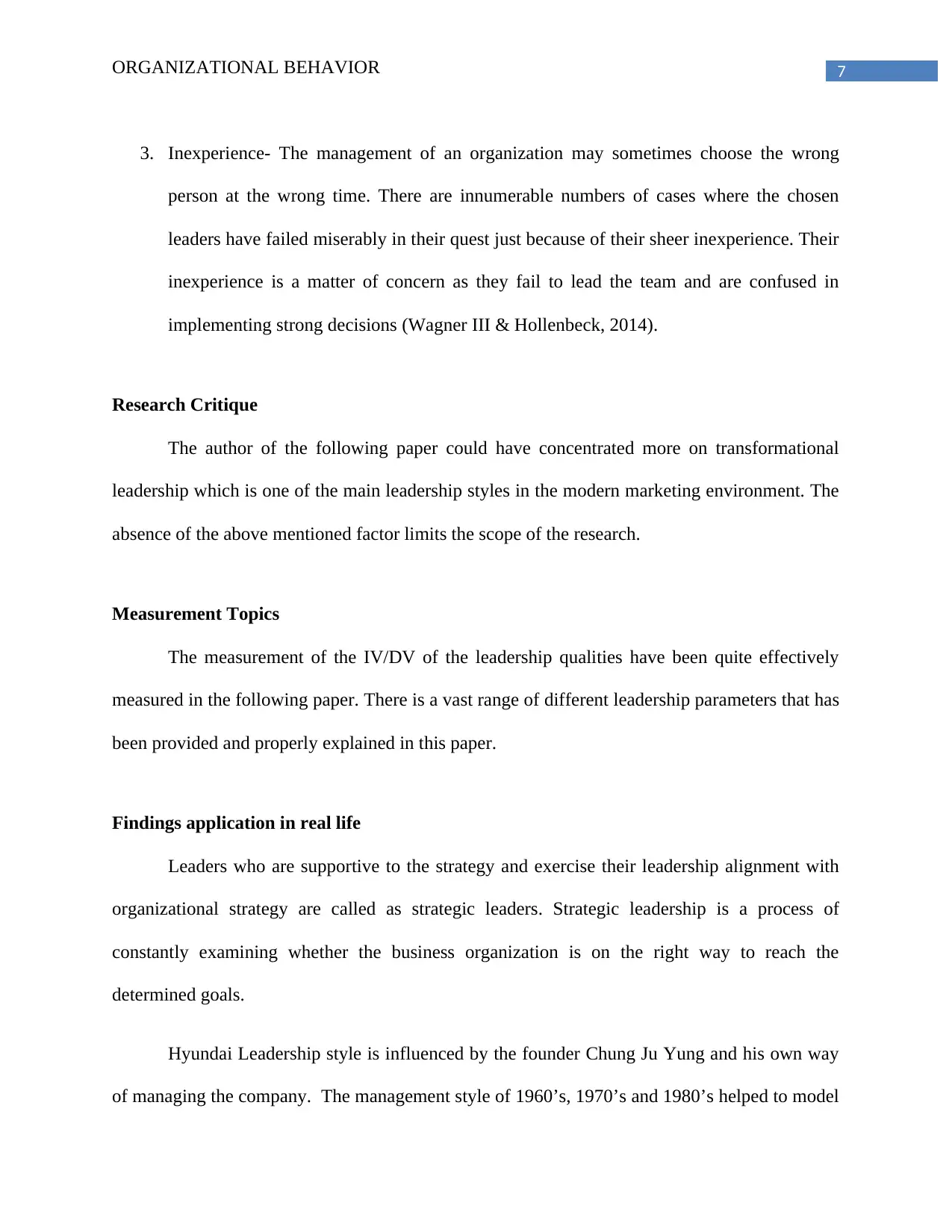
7ORGANIZATIONAL BEHAVIOR
3. Inexperience- The management of an organization may sometimes choose the wrong
person at the wrong time. There are innumerable numbers of cases where the chosen
leaders have failed miserably in their quest just because of their sheer inexperience. Their
inexperience is a matter of concern as they fail to lead the team and are confused in
implementing strong decisions (Wagner III & Hollenbeck, 2014).
Research Critique
The author of the following paper could have concentrated more on transformational
leadership which is one of the main leadership styles in the modern marketing environment. The
absence of the above mentioned factor limits the scope of the research.
Measurement Topics
The measurement of the IV/DV of the leadership qualities have been quite effectively
measured in the following paper. There is a vast range of different leadership parameters that has
been provided and properly explained in this paper.
Findings application in real life
Leaders who are supportive to the strategy and exercise their leadership alignment with
organizational strategy are called as strategic leaders. Strategic leadership is a process of
constantly examining whether the business organization is on the right way to reach the
determined goals.
Hyundai Leadership style is influenced by the founder Chung Ju Yung and his own way
of managing the company. The management style of 1960’s, 1970’s and 1980’s helped to model
3. Inexperience- The management of an organization may sometimes choose the wrong
person at the wrong time. There are innumerable numbers of cases where the chosen
leaders have failed miserably in their quest just because of their sheer inexperience. Their
inexperience is a matter of concern as they fail to lead the team and are confused in
implementing strong decisions (Wagner III & Hollenbeck, 2014).
Research Critique
The author of the following paper could have concentrated more on transformational
leadership which is one of the main leadership styles in the modern marketing environment. The
absence of the above mentioned factor limits the scope of the research.
Measurement Topics
The measurement of the IV/DV of the leadership qualities have been quite effectively
measured in the following paper. There is a vast range of different leadership parameters that has
been provided and properly explained in this paper.
Findings application in real life
Leaders who are supportive to the strategy and exercise their leadership alignment with
organizational strategy are called as strategic leaders. Strategic leadership is a process of
constantly examining whether the business organization is on the right way to reach the
determined goals.
Hyundai Leadership style is influenced by the founder Chung Ju Yung and his own way
of managing the company. The management style of 1960’s, 1970’s and 1980’s helped to model
Paraphrase This Document
Need a fresh take? Get an instant paraphrase of this document with our AI Paraphraser
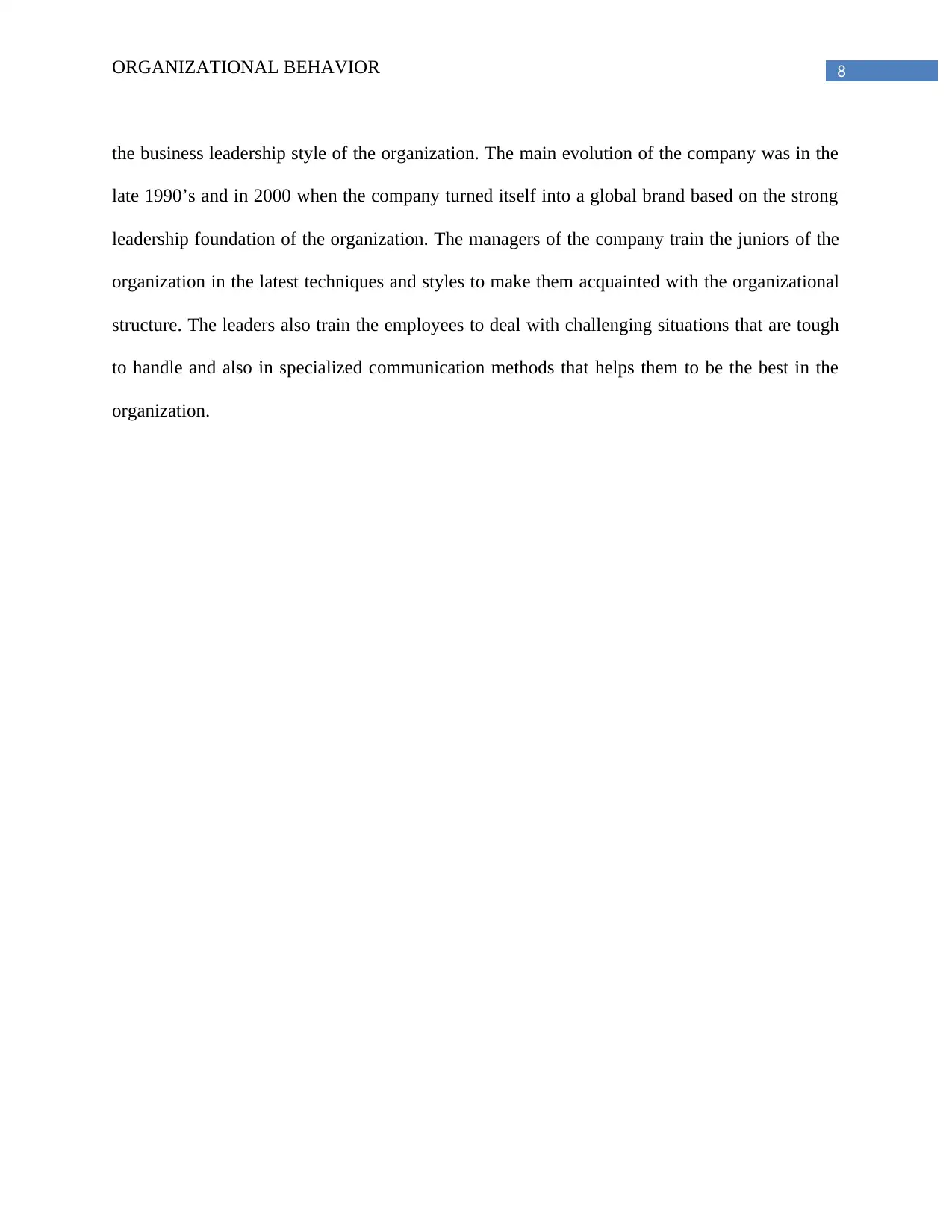
8ORGANIZATIONAL BEHAVIOR
the business leadership style of the organization. The main evolution of the company was in the
late 1990’s and in 2000 when the company turned itself into a global brand based on the strong
leadership foundation of the organization. The managers of the company train the juniors of the
organization in the latest techniques and styles to make them acquainted with the organizational
structure. The leaders also train the employees to deal with challenging situations that are tough
to handle and also in specialized communication methods that helps them to be the best in the
organization.
the business leadership style of the organization. The main evolution of the company was in the
late 1990’s and in 2000 when the company turned itself into a global brand based on the strong
leadership foundation of the organization. The managers of the company train the juniors of the
organization in the latest techniques and styles to make them acquainted with the organizational
structure. The leaders also train the employees to deal with challenging situations that are tough
to handle and also in specialized communication methods that helps them to be the best in the
organization.
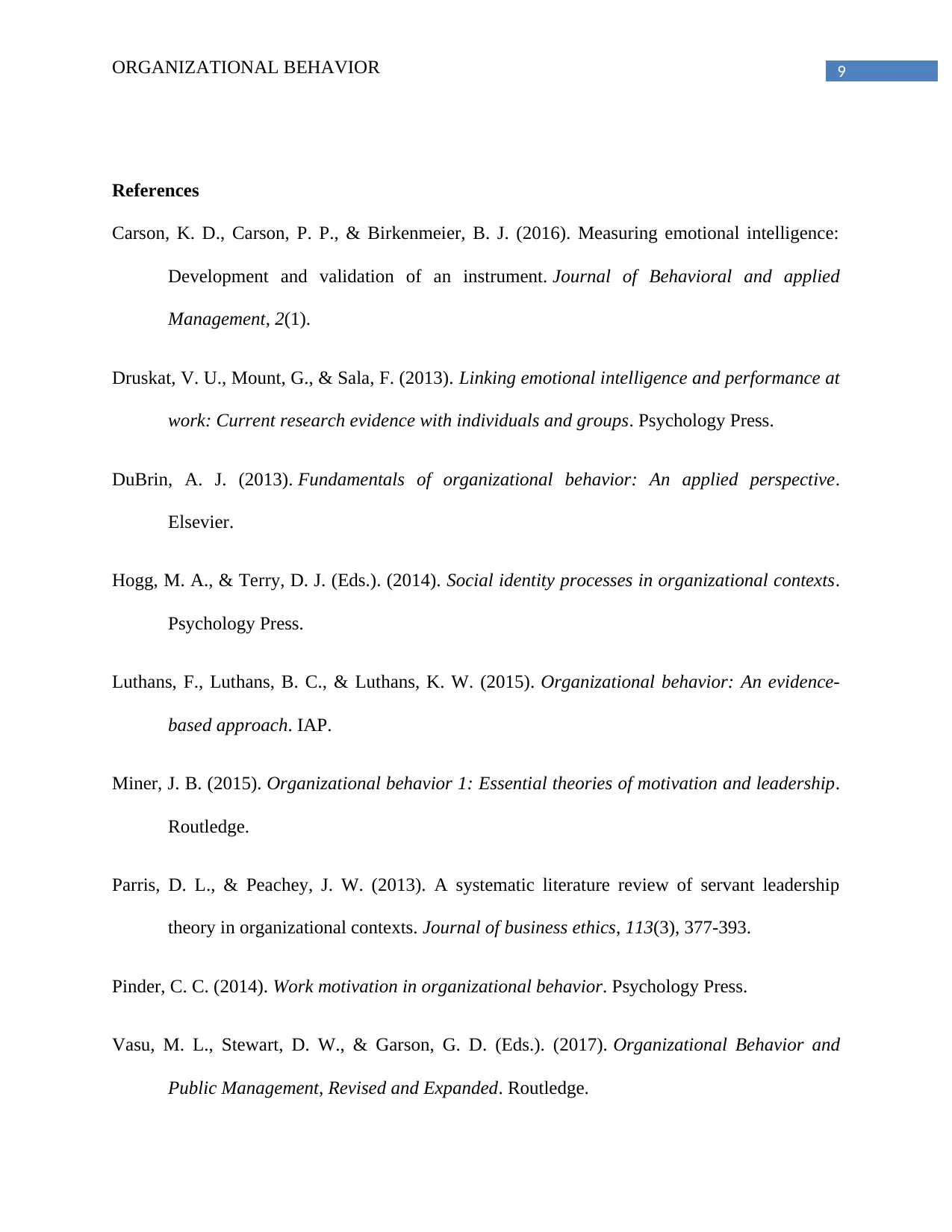
9ORGANIZATIONAL BEHAVIOR
References
Carson, K. D., Carson, P. P., & Birkenmeier, B. J. (2016). Measuring emotional intelligence:
Development and validation of an instrument. Journal of Behavioral and applied
Management, 2(1).
Druskat, V. U., Mount, G., & Sala, F. (2013). Linking emotional intelligence and performance at
work: Current research evidence with individuals and groups. Psychology Press.
DuBrin, A. J. (2013). Fundamentals of organizational behavior: An applied perspective.
Elsevier.
Hogg, M. A., & Terry, D. J. (Eds.). (2014). Social identity processes in organizational contexts.
Psychology Press.
Luthans, F., Luthans, B. C., & Luthans, K. W. (2015). Organizational behavior: An evidence-
based approach. IAP.
Miner, J. B. (2015). Organizational behavior 1: Essential theories of motivation and leadership.
Routledge.
Parris, D. L., & Peachey, J. W. (2013). A systematic literature review of servant leadership
theory in organizational contexts. Journal of business ethics, 113(3), 377-393.
Pinder, C. C. (2014). Work motivation in organizational behavior. Psychology Press.
Vasu, M. L., Stewart, D. W., & Garson, G. D. (Eds.). (2017). Organizational Behavior and
Public Management, Revised and Expanded. Routledge.
References
Carson, K. D., Carson, P. P., & Birkenmeier, B. J. (2016). Measuring emotional intelligence:
Development and validation of an instrument. Journal of Behavioral and applied
Management, 2(1).
Druskat, V. U., Mount, G., & Sala, F. (2013). Linking emotional intelligence and performance at
work: Current research evidence with individuals and groups. Psychology Press.
DuBrin, A. J. (2013). Fundamentals of organizational behavior: An applied perspective.
Elsevier.
Hogg, M. A., & Terry, D. J. (Eds.). (2014). Social identity processes in organizational contexts.
Psychology Press.
Luthans, F., Luthans, B. C., & Luthans, K. W. (2015). Organizational behavior: An evidence-
based approach. IAP.
Miner, J. B. (2015). Organizational behavior 1: Essential theories of motivation and leadership.
Routledge.
Parris, D. L., & Peachey, J. W. (2013). A systematic literature review of servant leadership
theory in organizational contexts. Journal of business ethics, 113(3), 377-393.
Pinder, C. C. (2014). Work motivation in organizational behavior. Psychology Press.
Vasu, M. L., Stewart, D. W., & Garson, G. D. (Eds.). (2017). Organizational Behavior and
Public Management, Revised and Expanded. Routledge.
⊘ This is a preview!⊘
Do you want full access?
Subscribe today to unlock all pages.

Trusted by 1+ million students worldwide
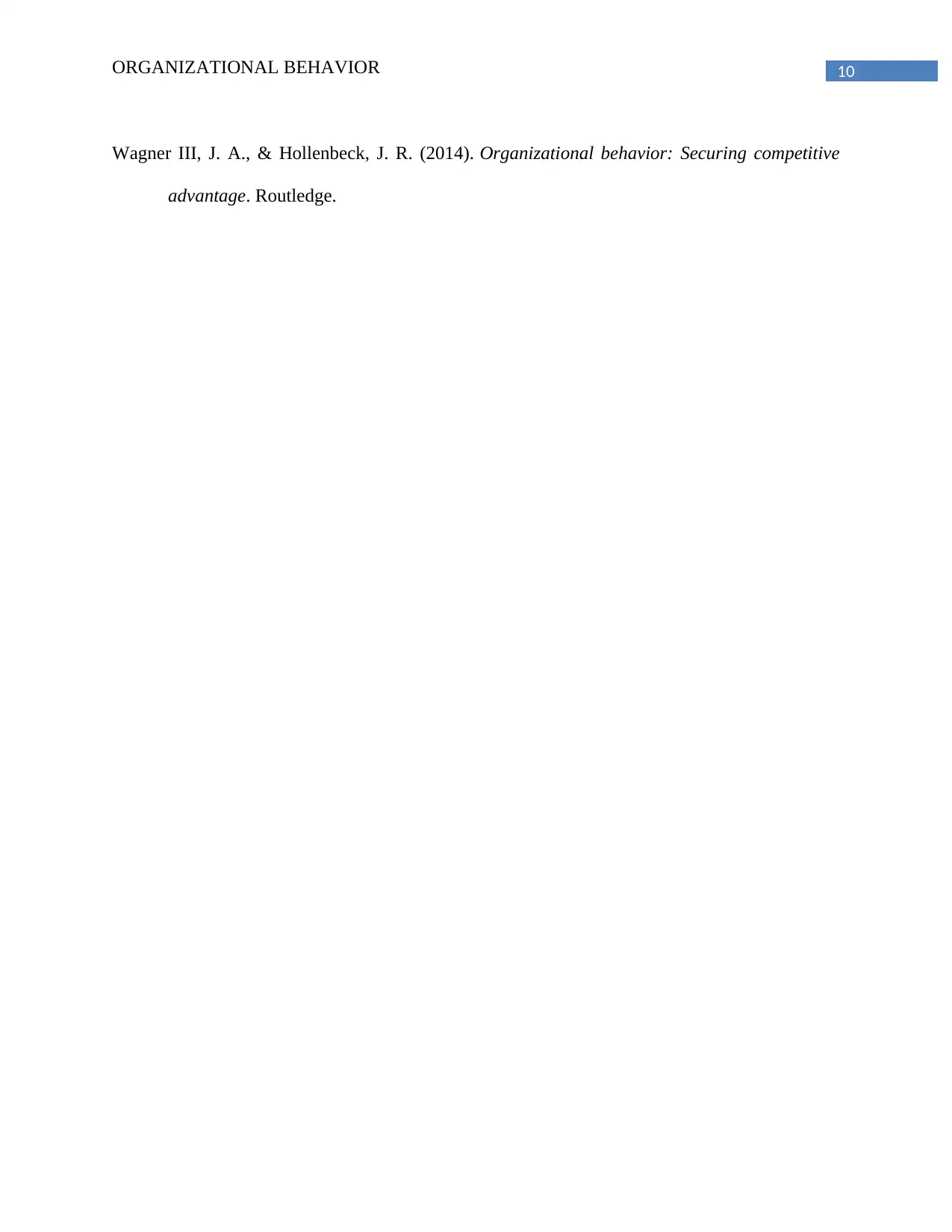
10ORGANIZATIONAL BEHAVIOR
Wagner III, J. A., & Hollenbeck, J. R. (2014). Organizational behavior: Securing competitive
advantage. Routledge.
Wagner III, J. A., & Hollenbeck, J. R. (2014). Organizational behavior: Securing competitive
advantage. Routledge.
1 out of 10
Related Documents
Your All-in-One AI-Powered Toolkit for Academic Success.
+13062052269
info@desklib.com
Available 24*7 on WhatsApp / Email
![[object Object]](/_next/static/media/star-bottom.7253800d.svg)
Unlock your academic potential
Copyright © 2020–2025 A2Z Services. All Rights Reserved. Developed and managed by ZUCOL.





